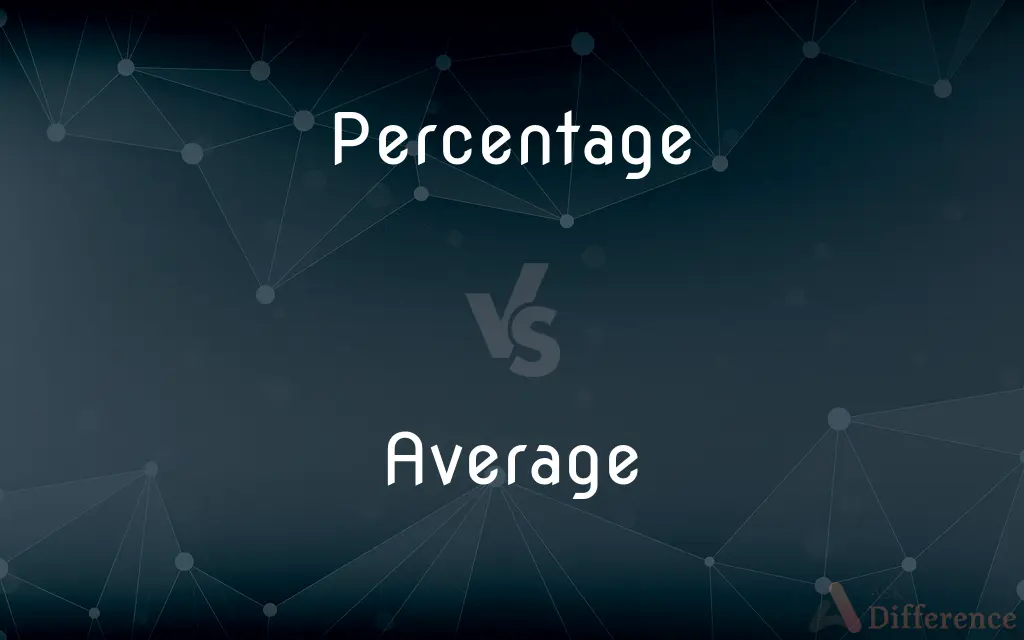Percentage vs. Average — What's the Difference?
By Tayyaba Rehman — Updated on November 2, 2023
A percentage represents a part of a whole as a fraction of 100, while an average is a value representing the sum of elements divided by the number of elements.

Difference Between Percentage and Average
Table of Contents
ADVERTISEMENT
Key Differences
A percentage is a mathematical term that describes a number expressed as a fraction of 100. It is a way to quantify proportions with a common baseline of 100, making it easier to compare different values. An average, however, is a statistical concept used to find the central or typical value of a set of numbers by dividing the sum of all values by the quantity of numbers.
The term "percentage" is used in a variety of contexts, such as in finance to express interest rates, in education to report grades, and in statistics to describe data. An average is commonly used to summarize sets of data, like calculating the average score on a test or the average salary in a profession. Both are numerical methods that provide different types of information about data sets.
When we calculate the percentage of a quantity, we are effectively scaling the quantity to a value out of 100. This scaling allows for direct comparison between different sizes of quantities. Averages do not scale data but instead centralize it, providing a single value that summarizes the whole set, which can be used to understand the general performance or status of the data set.
Understanding percentages is crucial for interpreting many aspects of daily life, such as sales tax, discount rates, or demographic statistics. Understanding averages is equally important when we aim to find the norm or the middle ground of any data set, like the average life expectancy or the average cost of living.
Percentage increases and decreases are used to represent change in terms of a hundredfold scale, while averages are used to depict the change by indicating the new central value after combining old and new data. Both percentage and average are fundamental in data analysis, and they are applied based on the need to either compare (percentage) or to consolidate information (average).
ADVERTISEMENT
Comparison Chart
Fundamental Meaning
A part of a whole represented out of 100.
The sum of values divided by the number of values.
Representation
Typically expressed with a "%" symbol.
No specific symbol, often just stated as is.
Use Cases
Comparing quantities, determining ratios.
Finding the central tendency of a dataset.
Calculation
Value divided by total value, then multiplied by 100.
Sum of all numbers divided by the count of numbers.
Example Context
Interest rates, test scores, demographic data.
Test score averages, average income.
Compare with Definitions
Percentage
Percentage can indicate a part of a population or group.
Only 15% of the applicants were accepted into the program.
Average
A number expressing the central or typical value in a set of data.
The average score on the exam was 75.
Percentage
Percentage denotes the rate or degree of something.
The percentage of battery life on my phone drops quickly when I play games.
Average
Average means ordinary or usual in quality or quantity.
The weather this summer has been average for our region.
Percentage
A proportion or share in relation to a whole, represented as a number out of 100.
She received a 90% on her math test, which was the highest in her class.
Average
In sports, average refers to a player's performance statistic.
His batting average this season is .300.
Percentage
Percentage is used to quantify the intensity or concentration of a solution.
The solution contains 10% salt.
Average
In colloquial language, an average is a single number taken as representative of a non-empty list of numbers. Different concepts of average are used in different contexts.
Percentage
In mathematics, a percentage (from Latin per centum "by a hundred") is a number or ratio expressed as a fraction of 100. It is often denoted using the percent sign, "%", although the abbreviations "pct.", "pct" and sometimes "pc" are also used.
Average
A number expressing the central or typical value in a set of data, in particular the mode, median, or (most commonly) the mean, which is calculated by dividing the sum of the values in the set by their number
The proportion of over-60s is above the EU average of 19 per cent
Percentage
A rate, number, or amount in each hundred
A large percentage increase
The percentage of Caesareans at the hospital was three per cent higher than the national average
Average
The apportionment of financial liability resulting from loss of or damage to a ship or its cargo.
Percentage
A fraction or ratio with 100 understood as the denominator; for example, 0.98 equals a percentage of 98.
Average
Constituting the result obtained by adding together several amounts and then dividing this total by the number of amounts
The average temperature in May was 4°C below normal
Percentage
The result obtained by multiplying a quantity by a percent.
Average
Amount to or achieve as an average rate or amount over a period of time; mean
Annual inflation averaged 2.4 per cent
Percentage
A proportion or share in relation to a whole; a part
The hecklers constituted only a small percentage of the audience.
Average
A number that typifies a set of numbers of which it is a function.
Percentage
An amount, such as an allowance, duty, or commission, that varies in proportion to a larger sum, such as total sales
Work for a percentage.
Average
See arithmetic mean.
Percentage
(Informal) Advantage; gain
There is no percentage in work without pay.
Average
An intermediate level or degree
Near the average in size.
Percentage
The amount, number or rate of something, regarded as part of a total of 100; a part of a whole.
A high percentage of secondary school leavers take a gap year.
Average
The usual or ordinary kind or quality
Although the wines vary, the average is quite good.
Percentage
A share of the sales, profits, gross margin or similar.
She gets a percentage for every vacuum cleaner sold.
Average
(Sports)The ratio of a team's or player's successful performances such as wins, hits, or goals, divided by total opportunities for successful performance, such as games, times at bat, or shots
Finished the season with a .500 average.
A batting average of .274.
Percentage
(informal) Benefit or advantage.
There was no percentage in staying at home.
Average
The loss of a ship or cargo, caused by damage at sea.
Percentage
A certain rate per cent; the allowance, duty, rate of interest, discount, or commission, on a hundred.
Average
The incurrence of damage or loss of a ship or cargo at sea.
Percentage
A proportion multiplied by 100
Average
The equitable distribution of such a loss among concerned parties.
Percentage
Assets belonging to or due to or contributed by an individual person or group;
He wanted his share in cash
Average
A charge incurred through such a loss.
Percentage
In finance, a percentage often refers to the rate of interest.
The bank offered a 2% interest rate on their savings account.
Average
(Nautical)Small expenses or charges that are usually paid by the master of a ship.
Average
(Mathematics)Of, relating to, or constituting an average.
Average
Being intermediate between extremes, as on a scale
A movie of average length.
A player of average ability.
Average
Usual or ordinary in kind or character
A poll of average people.
Average eyesight.
Average
Assessed in accordance with the law of averages.
Average
(Mathematics)To calculate the average of
Average a set of numbers.
Average
To do or have an average of
Averaged three hours of work a day.
Average
To distribute proportionately
Average one's income over four years so as to minimize the tax rate.
Average
To be or amount to an average
Some sparrows are six inches long, but they average smaller. Our expenses averaged out to 45 dollars per day.
Average
(mathematics) The arithmetic mean.
2=The average of 10, 20 and 24 is (10 + 20 + 24)/3 = 18.
Average
(statistics) Any measure of central tendency, especially any mean, the median, or the mode.
Average
Financial loss due to damage to transported goods; compensation for damage or loss.
Average
Customs duty or similar charge payable on transported goods.
Average
Proportional or equitable distribution of financial expense.
Average
(sports) An indication of a player's ability calculated from his scoring record, etc.
Batting average
Average
In the corn trade, the medial price of the several kinds of grain in the principal corn markets.
Average
The service that a tenant owed his lord, to be done by the animals of the tenant, such as the transportation of wheat, turf, etc.
Average
(not comparable) Constituting or relating to the average.
The average age of the participants was 18.5.
Average
Neither very good nor very bad; rated somewhere in the middle of all others in the same category.
I soon found I was only an average chess player.
Average
Typical.
The average family will not need the more expensive features of this product.
Average
(informal) Not outstanding, not good, banal; bad or poor.
Average
(transitive) To compute the average of, especially the arithmetic mean.
If you average 10, 20 and 24, you get 18.
Average
(transitive) Over a period of time or across members of a population, to have or generate a mean value of.
The daily high temperature last month averaged 15°C.
I averaged 75% in my examinations this year.
Average
(transitive) To divide among a number, according to a given proportion.
To average a loss
Average
(intransitive) To be, generally or on average.
Average
That service which a tenant owed his lord, to be done by the work beasts of the tenant, as the carriage of wheat, turf, etc.
Average
A tariff or duty on goods, etc.
Average
A mean proportion, medial sum or quantity, made out of unequal sums or quantities; an arithmetical mean. Thus, if A loses 5 dollars, B 9, and C 16, the sum is 30, and the average 10.
Average
Any medial estimate or general statement derived from a comparison of diverse specific cases; a medium or usual size, quantity, quality, rate, etc.
Average
In the English corn trade, the medial price of the several kinds of grain in the principal corn markets.
Average
Pertaining to an average or mean; medial; containing a mean proportion; of a mean size, quality, ability, etc.; ordinary; usual; as, an average rate of profit; an average amount of rain; the average Englishman; beings of the average stamp.
Average
According to the laws of averages; as, the loss must be made good by average contribution.
Average
To find the mean of, when sums or quantities are unequal; to reduce to a mean.
Average
To divide among a number, according to a given proportion; as, to average a loss.
Average
To do, accomplish, get, etc., on an average.
Average
To form, or exist in, a mean or medial sum or quantity; to amount to, or to be, on an average; as, the losses of the owners will average twenty five dollars each; these spars average ten feet in length.
Average
A statistic describing the location of a distribution;
It set the norm for American homes
Average
Amount to or come to an average, without loss or gain;
The number of hours I work per work averages out to 40
Average
Achieve or reach on average;
He averaged a C
Average
Compute the average of
Average
Approximating the statistical norm or average or expected value;
The average income in New England is below that of the nation
Of average height for his age
The mean annual rainfall
Average
Lacking special distinction, rank, or status; commonly encountered;
Average people
The ordinary (or common) man in the street
Average
Of no exceptional quality or ability;
A novel of average merit
Only a fair performance of the sonata
In fair health
The caliber of the students has gone from mediocre to above average
The performance was middling at best
Average
Around the middle of a scale of evaluation of physical measures;
An orange of average size
Intermediate capacity
A plane with intermediate range
Medium bombers
Average
Relating to or constituting the most frequent value in a distribution;
The modal age at which American novelists reach their peak is 30
Average
Relating to or constituting the middle value of an ordered set of values (or the average of the middle two in an even-numbered set);
The median value of 17, 20, and 36 is 20
The median income for the year was $15,000
Average
Average can denote the result obtained by adding several quantities together and dividing this total by the number of quantities.
The average cost of the three projects was $200.
Average
Average can also mean to achieve or amount to as an average rate or amount over a period.
Gas prices averaged $3 per gallon last year.
Common Curiosities
What exactly is a percentage?
A percentage is a number or ratio expressed as a fraction of 100.
Can a percentage be more than 100?
Yes, a percentage can be greater than 100 if the part exceeds the whole.
How is an average calculated?
An average is calculated by summing all numbers and dividing by the count of numbers.
Can average be used to describe general quality?
Yes, average can describe something as typical or ordinary.
How do you calculate a percentage?
To calculate a percentage, divide the part by the whole and multiply by 100.
Does average always reflect the most common value?
Not necessarily; average gives a central tendency, which may not be the most common value.
What does an average tell you?
An average gives you the central value of a set of numbers.
Are percentages always based on 100?
Yes, percentages are always relative to a base of 100 for consistency.
Is the median the same as the average?
No, the median is the middle value in a list of numbers, while the average is the sum divided by the count.
Why is percentage useful?
Percentage is useful for comparing proportions to a standardized scale of 100.
What is a weighted average?
A weighted average is calculated by giving different values in a dataset different levels of importance.
How do outliers affect averages?
Outliers can skew averages, making them higher or lower than the central trend of the rest of the data.
What's an example of percentage in daily life?
A common daily example is a sales tax added to purchases, expressed as a percentage.
In what contexts are percentages most commonly used?
Percentages are commonly used in financial contexts, statistical data, and reports of change.
What does it mean to average out?
To average out means to reach an average over time or through repeated instances.
Share Your Discovery

Previous Comparison
Mopping vs. Sweeping
Next Comparison
Mittimus vs. WarrantAuthor Spotlight
Written by
Tayyaba RehmanTayyaba Rehman is a distinguished writer, currently serving as a primary contributor to askdifference.com. As a researcher in semantics and etymology, Tayyaba's passion for the complexity of languages and their distinctions has found a perfect home on the platform. Tayyaba delves into the intricacies of language, distinguishing between commonly confused words and phrases, thereby providing clarity for readers worldwide.













































